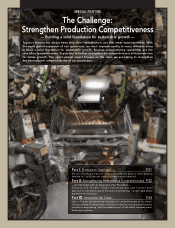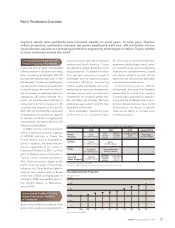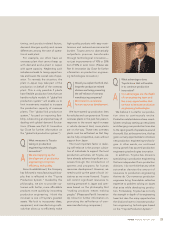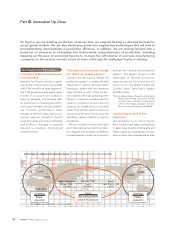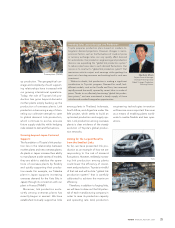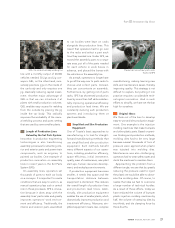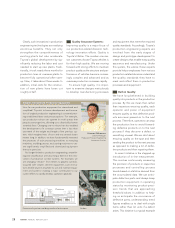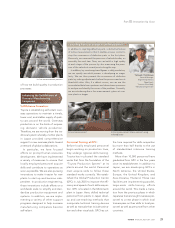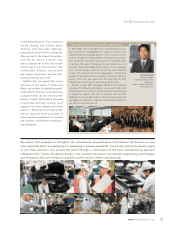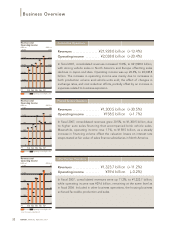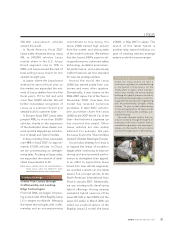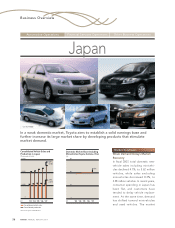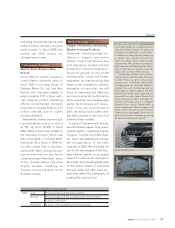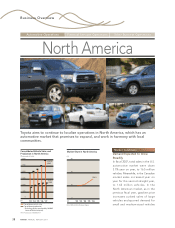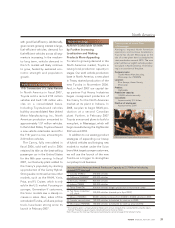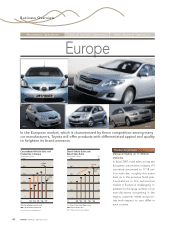Toyota 2007 Annual Report Download - page 32
Download and view the complete annual report
Please find page 32 of the 2007 Toyota annual report below. You can navigate through the pages in the report by either clicking on the pages listed below, or by using the keyword search tool below to find specific information within the annual report.
30 ANNUAL REPORT 2007
Shop-Based Support System:
Toyota undertakes shop-based activi-
ties to improve specific production
processes in order to standardize and
disseminate constantly evolving pro-
duction engineering and techniques
around the world. Until now, mother
plants in Japan have mainly shoul-
dered technical support for overseas
plants. However, problems with this
approach have emerged with the
introduction of new technologies and
the increasing production of models
sold only in local markets.
To rectify this, we created a system
that staff members of each shop from
domestic plants and production engi-
neering departments use to identify
the best-practice or global best pro-
cesses. This system cross-sectionally
links the staff at stamping shops, paint
shops, and other shops. Grouped by
shop, staff members gather and share
information on transferring technology to
overseas plants and on human resources
development as well as consider con-
crete ways of achieving these tasks.
The support provided to overseas
plants lost uniformity because mother
plants in Japan have long traditions
and have evolved their own unique
manufacturing styles. Therefore, we
prepared basic plant requirements,
which summarize the common ele-
ments of plants’ approaches, as a
standardized tool to help overseas
manufacturing companies learn and
become self-reliant. Such initiatives
are forming a major part of Toyota’s
efforts to further the self-reliance of
overseas manufacturing companies.
Global Human Resources
Development:
Toyota’s human resources develop-
ment aimed at increasing the self-
reliance of overseas manufacturing
companies goes beyond skills training
of key production personnel. World-
wide, we are also introducing a broad
spectrum of programs for the medi-
um-to-long-term training of produc-
tion-related personnel.
For example, “Pro-Win” Professional-
Will Interact Needs is a three-year pro-
gram for developing professionals in
production-related divisions. In addition,
we implement personnel exchange
programs that account for more than
250 trainees each year. The “OT-Clab”
Overseas Trainee-Culture and Business
initiative develops future production
managers by sending young employees
from Japan to overseas production
bases as trainees. In the opposite direc-
tion, employees from overseas manu-
facturing companies come to Japan
for a limited period under the “ICT”
Intra-Company Transferee program.
Progress toward Self-Reliance:
The multifaceted initiatives that we
pursued to increase the self-reliance of
overseas manufacturing companies
are steadily showing results. One
example is the production of the Camry
Overview of Shop-Based Activities
Advancing activities for separate production-process shops
Motomachi Plant
Takaoka Plant
Tsutsumi Plant
Production Engineering
Stamping staff
Stamping staff
Stamping staff
Stamping-based activities Painting-based activities Assembly-based activities
Painting staff
Painting staff
Painting staff
Assembly staff
Assembly staff
Assembly staff
Assembly staff
Stamping staff Painting staff
Richard Finchett
Senior Manager
European Global Production
Center
Global Production Centers Overseas
In March 2006, the European Global Production Center (E-
GPC) was established at Toyota’s U.K. plant as a branch of
the Global Production Center (GPC) in Japan. At E-GPC,
our job is to develop trainers that will work in the produc-
tion-related divisions of Toyota’s European plants. I went to
GPC to learn how to become a trainer in February 2004.
Using that experience, I now teach trainers in Europe.
E-GPC serves plants in the United Kingdom, France,
Turkey, Poland, Portugal, the Czech Republic, South Africa,
and Russia. Although certain difficulties arise because
trainees come from countries with different languages, cus-
toms, and cultures, that makes my job even more reward-
ing. On average, trainees come here for one week. Then,
they return to their plants and use the know-how and skills
gained at E-GPC to train their team
members. In addition, we plan to have
trainers come from plants around Europe
to teach at E-GPC.


